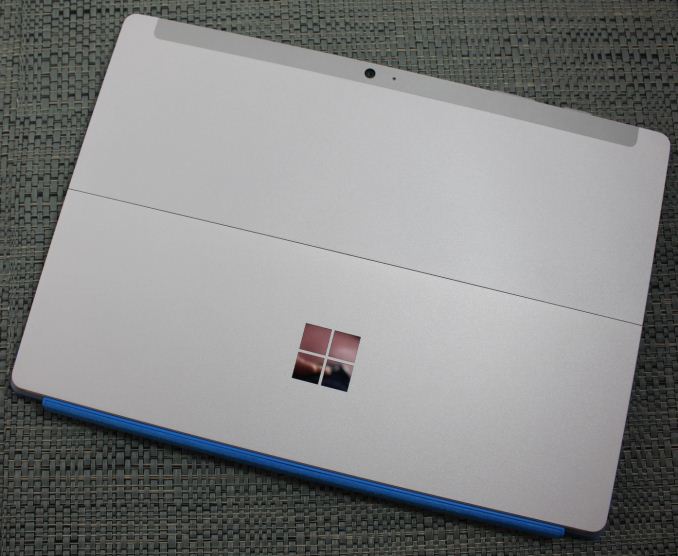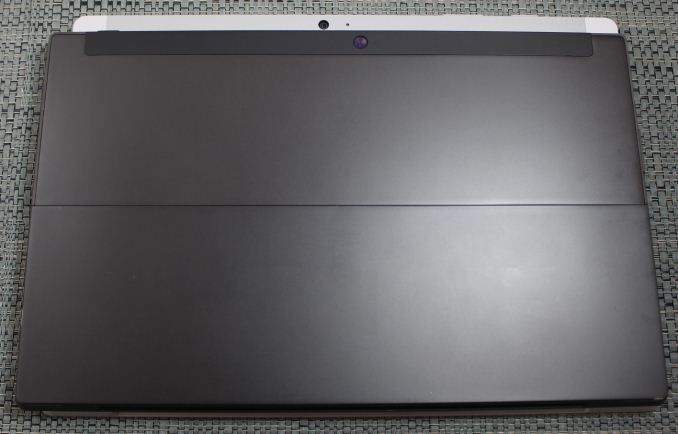The Surface 3 Review
by Brett Howse on May 4, 2015 9:00 AM EST
The Surface lineup for Microsoft has been extremely interesting to watch. What first launched in October 2012 as the Surface RT has been constantly iterated upon, and of course the Surface Pro line has evolved even faster. Surface Pro 3 has finally provided Microsoft with something that critics and consumers alike seem to have bought in to, and sales have been very strong since the Pro 3 was launched on May 20th 2014. However there has always been questions about the “consumer” version of Surface. Surface RT was, frankly, a sales disaster. The much improved Surface 2 fixed many of its shortcomings, but certainly did not set the world on fire. So now we have the third generation Surface, aptly named the Surface 3. There are a pile of changes that Microsoft has made to this generation of device, and obviously their hopes are that Surface 3 will be as popular as the Surface Pro 3 has been, but extending the device back down to a lower price point.
That price point is important. As much as the Surface Pro 3 has gained its share of fans, it is far from cheap. The most inexpensive model starts at $799, and for that you still do not get the keyboard. Surface 3 moves that bar down significantly, and the starting price is the exact same as the original Surface RT, at $499. Microsoft had to trim down the Pro model to hit this price point, but the cuts were well placed.
 Surface RT compared to Surface 3
Surface RT compared to Surface 3
I think looking at the Surface 3 in a vacuum would be improper, since the device now is really an evolution of the previous two Surface models. From a build quality standpoint, the original Surface RT was top notch, with its VaporMg case, the revolutionary kickstand, and high attention to detail for all of the aspects from buttons to display. I think in 2015 it is pretty obvious what the shortcomings of the Surface RT were though. Performance was less than acceptable with the Tegra 3 SoC on board, and Surface RT was handicapped with the confusingly named Windows RT operating system and the lack of software compatibility that goes with using an ARM CPU instead of traditional x86. Surface 2 fixed the performance issue by moving to NVIDIA’s Tegra 4 SoC, and while not the outright fastest tablet chip, it was at least in the ballpark. However it kept the Windows RT operating system at a time when everyone else had abandoned it.
Surface 3 has fixed that final issue and at the same time made some amazing improvements to the overall design and feel. Full x86 Windows is on tap, for better or for worse, and powered by a brand new SoC. This must be a special moment in history where a Microsoft built device is the launch vehicle for a brand new product from Intel. The Surface 3 is powered by the 14nm Intel Atom x7, in this case the x7-Z8700 model which is the current top of the line Atom processor. Codenamed Cherry Trail, this is the massaged Bay Trail cores now built on Intel’s now mature 14nm FinFET process, and they include the same GPU cores as Broadwell.
| Microsoft Surface Comparison | |||
| Surface 3 (Base) | Surface 3 (High) | Surface 2 | |
| Size | 10.52 x 7.36 x 0.34 inch 267 x 187 x 8.7 mm |
10.81 x 6.79 x 0.35 inch 275 x 173 x 8.8 mm |
|
| Weight | 1.37 lbs - 622 g | 1.49 lbs - 675 g | |
| Display | 10.8-inch ClearType Full HD Plus 1920x1280 resolution, 3:2 ratio 10-point multi-touch Surface Pen Support |
10.6-inch ClearType Full HD 1920 x 1080 resolution, 16:9 ratio 5-point multi-touch |
|
| Battery | 28 Wh, 13 W AC Adapter | 31.5 Wh, 24 W AC Adapter | |
| Storage | 64GB | 128GB | 32GB or 64GB eMMC |
| RAM | 2GB | 4GB | 2GB |
| CPU | Atom x7-Z8700 Quad Core 14nm 1.6 GHz Base Frequency 2.4 GHz Burst Frequency |
NVIDIA Tegra 4 4x ARM Cortex-A15 @1.7GHz |
|
| WiFi | Marvell 802.11ac + BT 4.0 LTE Models at a later date |
802.11n + BT 4.0 | |
| Ports | USB 3.0, Mini-DisplayPort, microSD, Micro USB charging, 3.5mm Headset Jack |
USB 3.0, micro-HDMI, microSD, proprietary charging | |
| Software | Windows 8.1 Office 365 Personal with 1TB OneDrive (1-year) |
Windows RT 8.1 Office 2013 RT Home & Student Edition |
|
| Front Camera | 3.5 MP | 3.5 MP | |
| Rear Camera | 8.0 MP with Autofocus | 5.0 MP | |
| Operating System | Windows 8.1 64-bit | Windows RT 8.1 | |
| Warranty | 1-year limited | 1-year limited | |
| Price | $499 | $599 | $449 |
In addition to the new SoC, Surface 3 can be purchased with up to 128 GB of eMMC storage, and the higher storage models also come with 4 GB of RAM. This compares to the base model which is 2 GB of RAM and 64 GB of storage, which is already one of the big improvements Microsoft has made with Surface. 32 GB of storage on a Windows tablet is really the bare minimum required, and the move to 64 GB as the base is going to make this tablet far more usable. You can of course add more storage with a micro SD card, but until Windows gets the great SD card support from Windows Phone, it still means that you need to manage your storage more than you should have to.
There are so many changes with the Surface 3 that really, this is likely the Surface that most people wanted from day one, but did not know it. First up is the new (again) kickstand.










265 Comments
View All Comments
bobjones32 - Monday, May 4, 2015 - link
Well, what's your definition of "strong"?If the Surface Pro 3's main competitor is the MacBook Air, then that should be the sales benchmark, not tablets. Apple sold around 4.5 million Macs in total for its most recent quarter - so that includes all Airs, Pros, desktops, etc.
If as you math'd Microsoft sold ~700k Surface Pro 3s, that seems pretty good compared to the record-highest number that Apple has ever sold of all Macs put together, considering that the SP3 still isn't sold in as many countries, is still a relatively new entry, and has the public taint of Windows 8 on it.
Speedfriend - Tuesday, May 5, 2015 - link
Strong is a correct description.In the Dec quarter Surface sold over 1m units versus the 1.5m-2m MacBook airs that Apple sold in the quarter. I would call that a fantastic performance.
In the last quarter Surface revenue grew 46%, versus Mac revenue growing 2% and iPOAd revenue falling a staggering 28%. Again I would call that a fantastic performance!
For a product that Microsoft is forced to price at a premium (or risk alienating its OEM cusotmers even more), it is selling exceptionally well.
jhoff80 - Monday, May 4, 2015 - link
Yes, the charging connector on past Surface devices has been finicky (though I've never used a Surface 2 or Pro 3 myself), but with the design of Microsoft's charging cords all keeping the cord parallel with the device, I couldn't imagine being limited to a non-reversible connector like this one is.Depending on how I'm sitting/positioning the Surface Pro 2 on my lap or desk, sometimes cord up is far more convenient and sometimes cord down is. Not having that choice would be a huge pain with this cord design, and so I'm a little surprised that Microsoft didn't at least change away from that sort of design with microUSB as their connector.
chizow - Monday, May 4, 2015 - link
Nice review Brett, great background info for those that were unaware of the evolution the Surface non-Pro has undergone. I was initially optimistic about the Surface RT, but once I found out its limitations I was one of the many that asked for an Atom-based x86 replacement to fill in that low-end gap to bring Surface's great design and interface to the masses.Now that we have it, it is certainly a nice device but I don't feel the price point is low enough, nor the performance good enough, to wow the masses. We will see, but it doesn't look like Cherry Trail was much of an advancement over previous Bay Trail, which is coming up on 2 years old. Maybe if MS included the Stylus (a net minus over the Pro) and/or the type pad, it would be a better deal, but with the various specials and incentives Microsoft typically offers even on new Surface parts, there is hope for this part yet.
Michael Bay - Wednesday, May 6, 2015 - link
2W for SoC on x86 is not an advancement for you?shodanshok - Monday, May 4, 2015 - link
A question about connected standby and hibernation: Microsoft's documentation state that hibernation is entered only with critically low battery level (and this level is configurable using the advanced power settings). This match my experience on two different Win8.1 tablets (HP Stream 7 and Dell Venue 11 Pro 7000).On the other hand, on your review you stated that Surface 3 enter hibernate after "some hours" of idling in connected standby.
Is the Surface 3 behaving differently than other Win8.1 tablets (and from Microsoft own documentation?)
LINK: https://msdn.microsoft.com/en-us/library/windows/h...
Brett Howse - Monday, May 4, 2015 - link
Here you go: https://support.microsoft.com/en-us/kb/2998588/lilmoe - Monday, May 4, 2015 - link
how long does it take to resume from hibernation? <5 seconds? 5-10? >10?shodanshok - Tuesday, May 5, 2015 - link
So it was a custom power profile from Microsoft. Very interesting to know...Thank you ;)
mva5580 - Monday, May 4, 2015 - link
The Web Browsing battery test is baffling to me. How can it possibly be LESS than a SP3? Atom processor, smaller screen, lower resolution. I don't get that one at all.